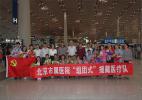Nov. 8, 2016 -- "Tibet has a vast territory with sparsely populated and few hospitals. Additionally, the medical level is backward. Thus, Tibet increasingly need for 'Internet plus treatment'", said Li Jing, aid-Tibet doctor and vice president of the Second People's Hospital of Tibet Autonomous Region.
Li Jing used to be a cardiologist at Beijing Hospital. Since November 2014, he has worked as the aid-Tibet doctor. To November this year, his work period is to complete, but Li Jing still has one unfulfilled aspiration and would like to continue his work in Tibet.
In August 2015, there was a new mode of counterpart aid-Tibet, "group form" of medicine personnel. The counterpart provinces and municipalities provide one-to-one support for a prefecture-level People's hospital, and comprehensively boost the development of Tibet's medical cause, from medical department building, staff training to hospital management. The essence is to change the blood-transfusion to blood-making aid and build Tibet's own medical team. After over one year, there were remarkable results.
The National Health and Family Planning Commission of China has organized 83 top hospitals to provide medical assistance to 74 People’s hospitals of county-level in Tibet this year. Beijing Hospital, Li Jing’s original working place, interfaced with Ngari’s Gegye People’s Hospital which has harsher conditions.
The current method of interfacing with the county hospitals is to send four or five professional doctors to mentor the local staff. There are definite benefits, but also deficiency.
As they can’t possibly cover all the dozens of departments, it is hard to complete all the medical work. Also, the construction of a key department can’t be completed in a decade,” Li Jing said.
Due to the vast territory and a sparse population, transport and other factors, People’s hospitals of Tibet’s regional, prefecture and county and other levels have relatively limited service ranges.
Li Jing has almost been round all of Tibet during the two-year aid work, which has given him a greater understanding of Tibet’s medical situation.
In the context of “group form” medical aid, he wants to do some refining to make the medical model more suitable for Tibet and then maximize the effect of this form.
He confirms further the necessity to promote “Internet plus treatment” in Tibet, after knowing that people with simple illnesses could not receive timely treatment just due to the local’s poor medical level.
"Traditional telemedicine consultations not only have high costs of input and maintenance, but also have poor operability or timeliness in Tibet.” Li Jing’s vision of “Internet plus treatment” is to combine the telemedicine consultation inside the hospital with health management outside the hospital, which is already in practice in Gegye County.
With Li Jing’s leading, Chinese Research Hospital Association has already provided Gegye People’s Hospital with a software platform worth one million yuan. With the real-time monitoring of patients’ data gathered by informatization, Beijing Hospital’s experts can make joint consultation with local doctors via a mobile terminal.
Health management outside the hospital, by applying the testing and inspection integrative machine, and wearable mobile devices, will take health monitoring and guidance for farmers, herdsmen and other groups outside the hospital and combine with joint consultation.
Li Jing said that application of the mobile terminal can greatly improve service scope and treatment capacity of county hospitals. It will fully mobilize inland and aid experts as well as other resources, and achieve the goal of improving local medical level through long-term medical practice.
"Of course, these are all based on joint telemedicine consultation inside the hospital.” This kind of new medicine model has strong practical effects in early prevention, avoiding the occurrence of malignant diseases and lengthening lifespan, he added.
Li Jing said that they are not only providing medical services, but also precise poverty alleviation. “Poverty caused by and returning to poverty due to sickness” is the difficulty for poverty alleviation in Tibet.
Ngari is such a representative, with tricky conditions and remoteness. Once done well in Gegye County, we can start promoting in other counties of Tibet.






